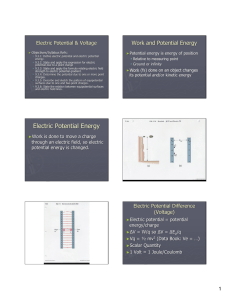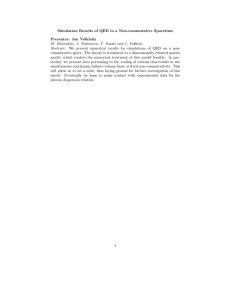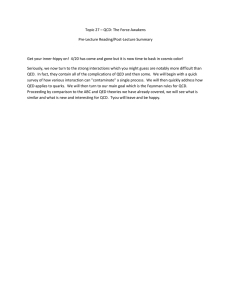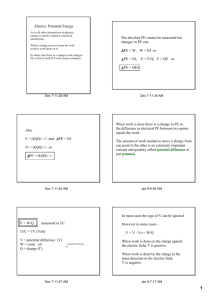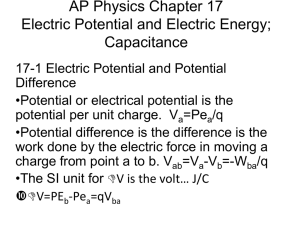Work, Energy, and Electric Potential Presentation
advertisement
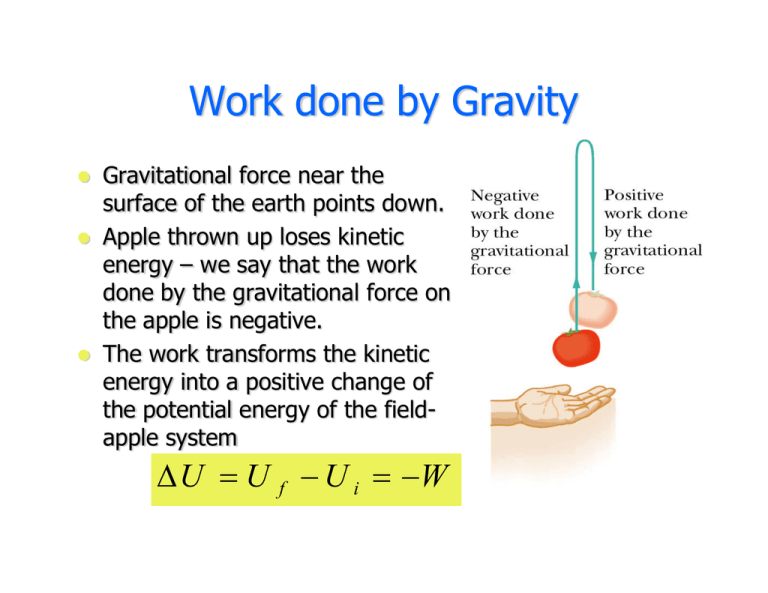
Work done by Gravity z z z Gravitational force near the surface of the earth points down. Apple thrown up loses kinetic energy – we say that the work done by the gravitational force on the apple is negative. The work transforms the kinetic energy into a positive change of the potential energy of the fieldapple system Δ U = U f − U i = −W Work done by Gravity z General equation for work is z F points down. z When the apple goes up d points up and r r W = F •d W = − Fd z In this case there is a positive change in the potential energy. Work done by Gravity z When the apple goes down d points down W = Fd z In this case there is a negative change in the potential energy. Work done by Electric Field z z Electric field near the surface of the earth points down (ignore gravity). When the electron moves up the work done on an electron by the electric field is: W = Fd z This results in a decrease in the potential energy of the fieldelectron system. Δ U = U f − U i = −W Electric Potential Energy z When electrostatic force acts between charged particles assign an electric potential energy, U z Difference in U of a charge at two different points, initial i and final f is ΔU = U f − U i Electric Potential Energy z When the system changes from initial state i to final state f electrostatic force does work ΔU = U f − U i = −W z z Electrostatic force is conservative Work done by force is path independent z Work is same for all paths between points i and f Electric Potential Energy & Reference Point Potential energy, U, is a scalar z Need to choose a reference point where U =0 z z Choose sea level to be zero altitude z What if we define Denver to be zero altitude? z Does the difference in altitude change? z Choose U =0 at i =∞ for electric potential Electric Potential Energy & Reference Point z Have several charges initially at infinity so Ui =0 z Move charges close together to state f z W∞ is work done by force to move particles together from infinity ΔU =Uf −Ui =Uf ΔU = −W U f = −W∞ Electric Potential Energy (Exercise) z A proton moves from point i to point f in a uniform electric field. z Does the electric field do positive or negative work on the proton? Electric Potential Energy (Exercise) z What is the work done by an electric field? r r W = F •d r r F = qE r r W = qE • d = qEd cosθ W = qEd cos(180) = − qEd Negative work Electric Potential Energy (Exercise) z Does the electric potential energy of the proton increase or decrease? ΔU = U f − U i = −W ΔU = −( − qEd ) = qEd Increases Electric Potential z Electric potential, V, is defined as the electric potential energy, U, per unit charge U V = q z Potential, V, is characteristic of the electric field only z Unique value at any point in an electric field Electric Potential z Electrostatic potential difference, ∆V, between points i and f Ui ΔU W ΔV = V f − Vi = − = =− q q q q Uf z V is a scalar and can be +, -, or 0 z Using reference point of Ui=0 at infinity W∞ V =− q Electric Potential Important difference between U and V z Electric Potential Energy, U, is energy of a charged object in an external E field z z Measured z in Joules (J) Electric Potential, V, is property of E field care if charged object is placed in E field or not z Measured in Joules per Coulomb (J/C) z Doesn’t Electric Potential Units z Define new SI unit for V (volt) z 1 volt = 1 joule per coulomb, V=J/C z Define E field in volts per meter (V/m) F E= q N ⎛ N ⎞⎛ V ⋅ C ⎞⎛ J ⎞ V = ⎜ ⎟⎜ ⎟= ⎟⎜ C ⎝ C ⎠⎝ J ⎠⎝ N ⋅ m ⎠ m Equipotential Surface z Equipotential surface - all points are at same electric potential, V W ΔV = V f − Vi = − q z W =0 if move between points i and f which lie on same potential surface z True regardless of path taken between points Equipotential Surfaces z For paths I and II W = −q ΔV = − q (V1 − V1 ) = 0 W = −q ΔV = −q (V3 −V3 ) = 0 z For paths III and IV W = − qΔV = − q(V2 − V1 )
